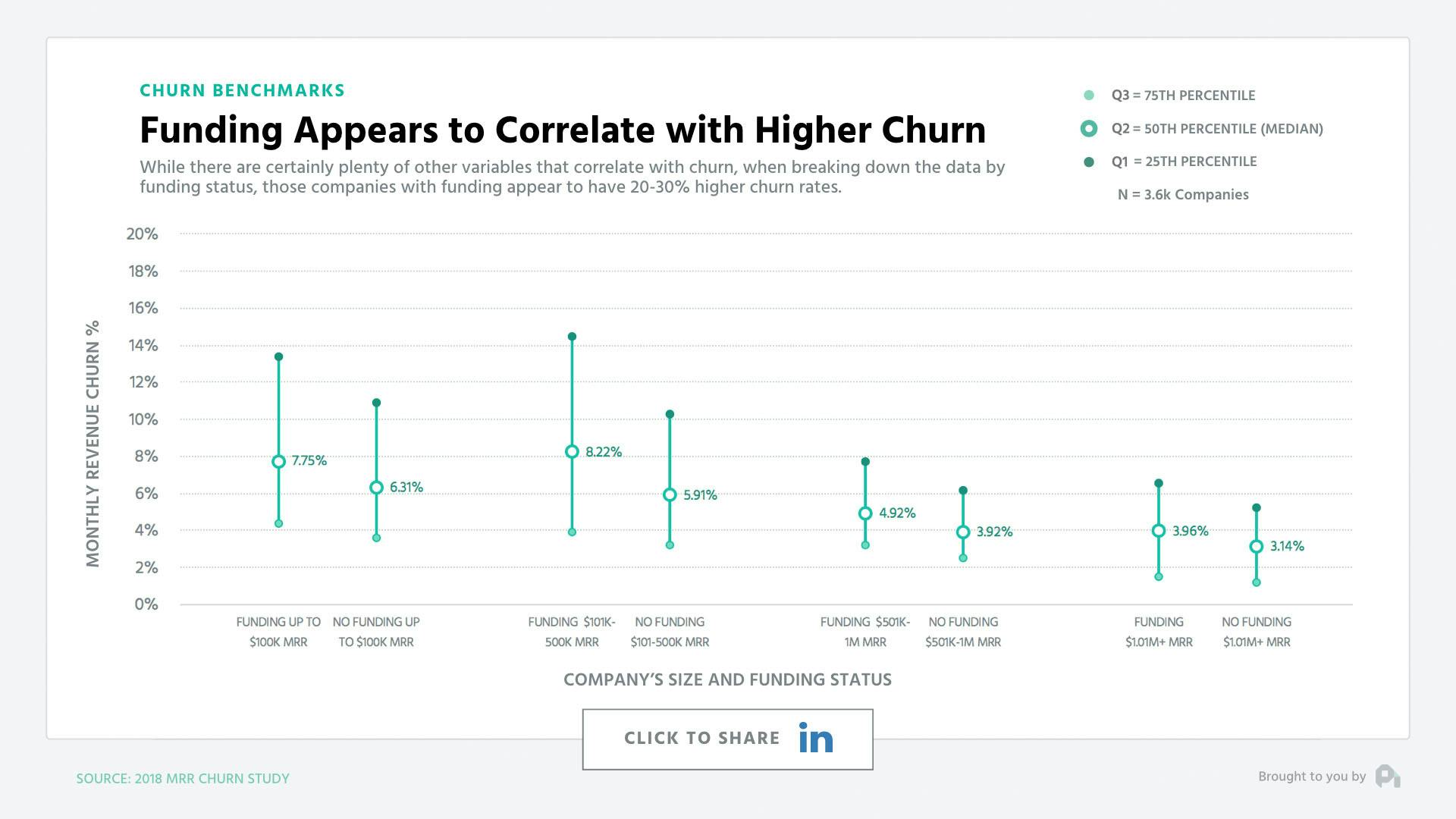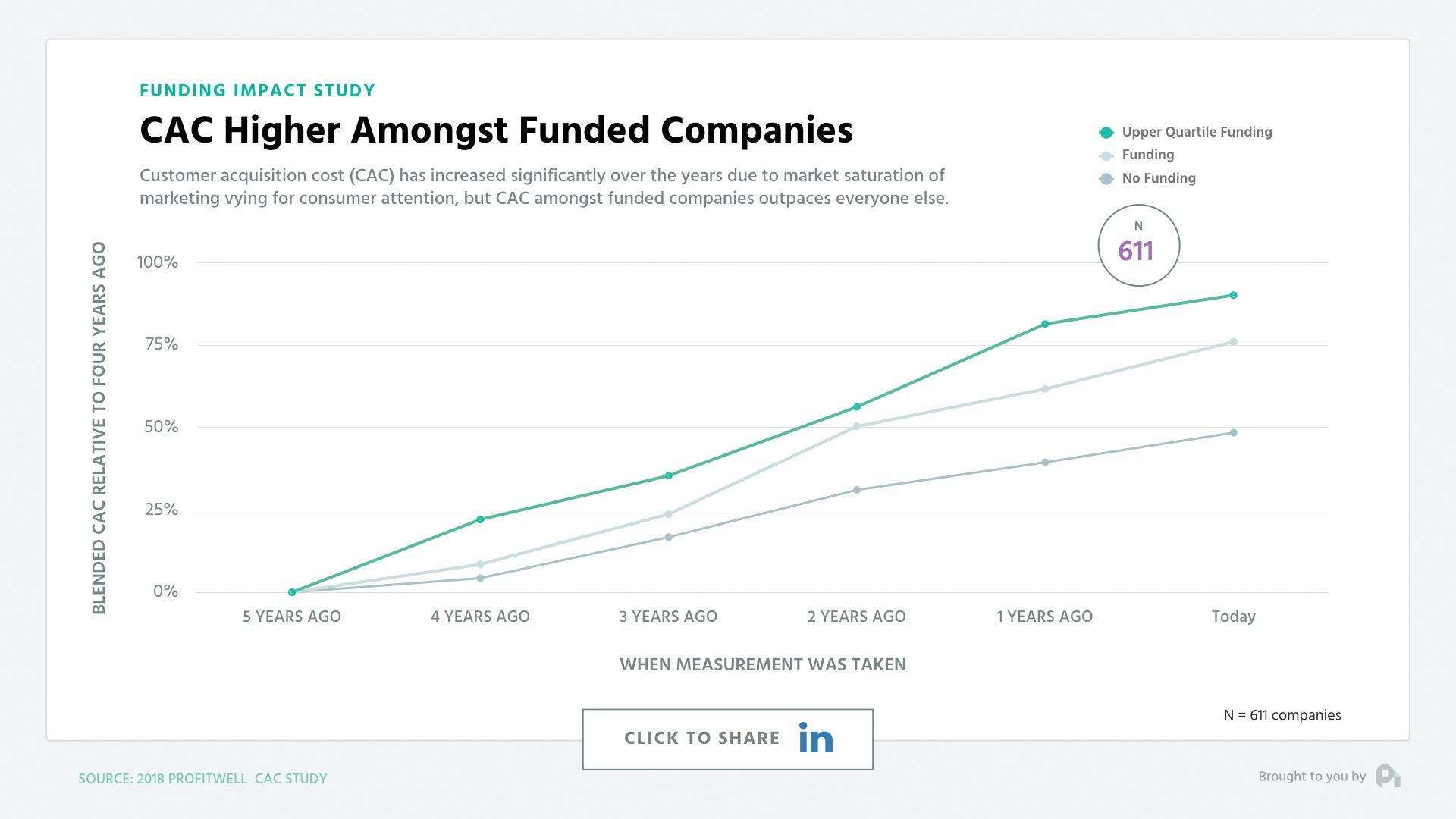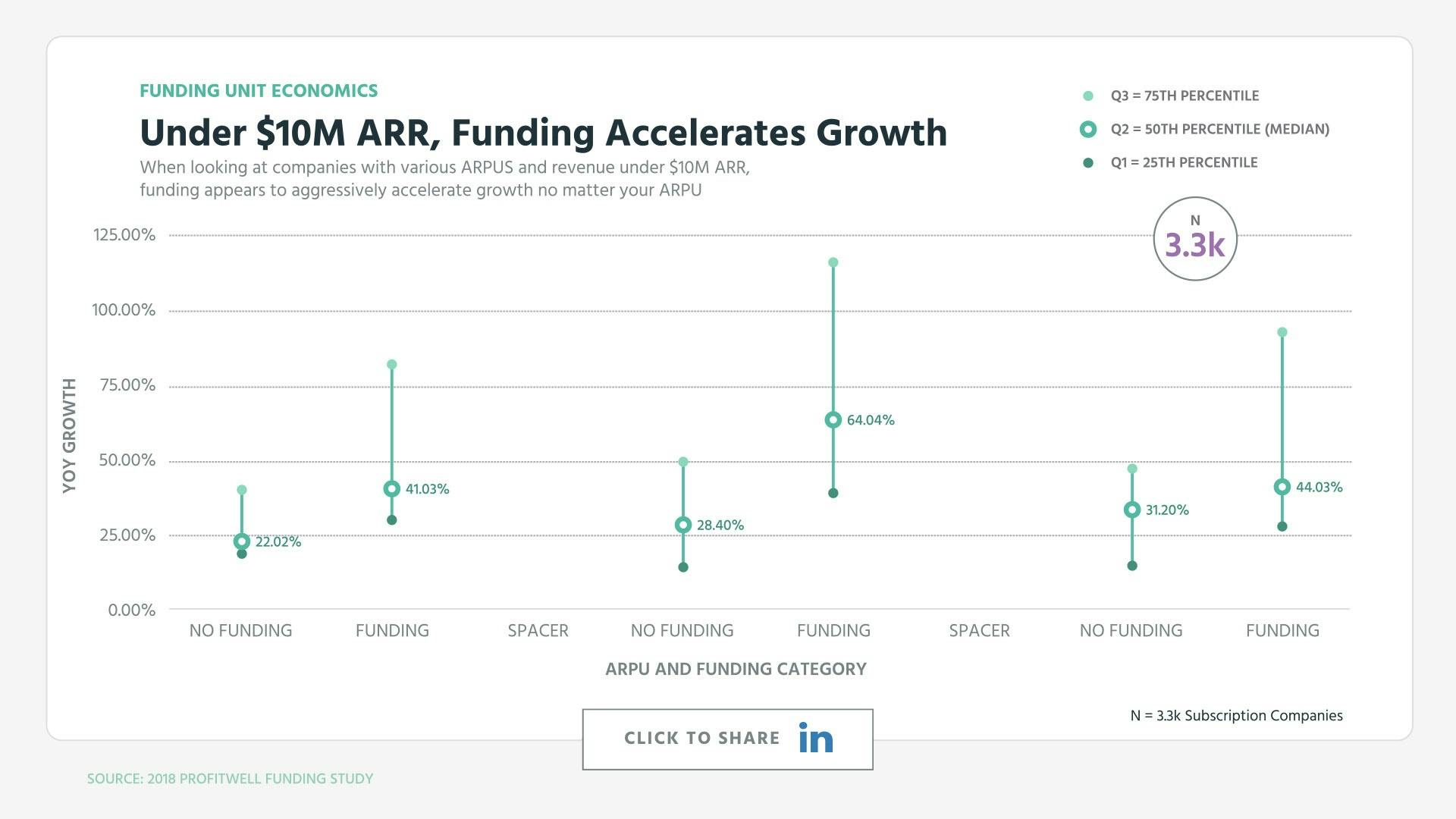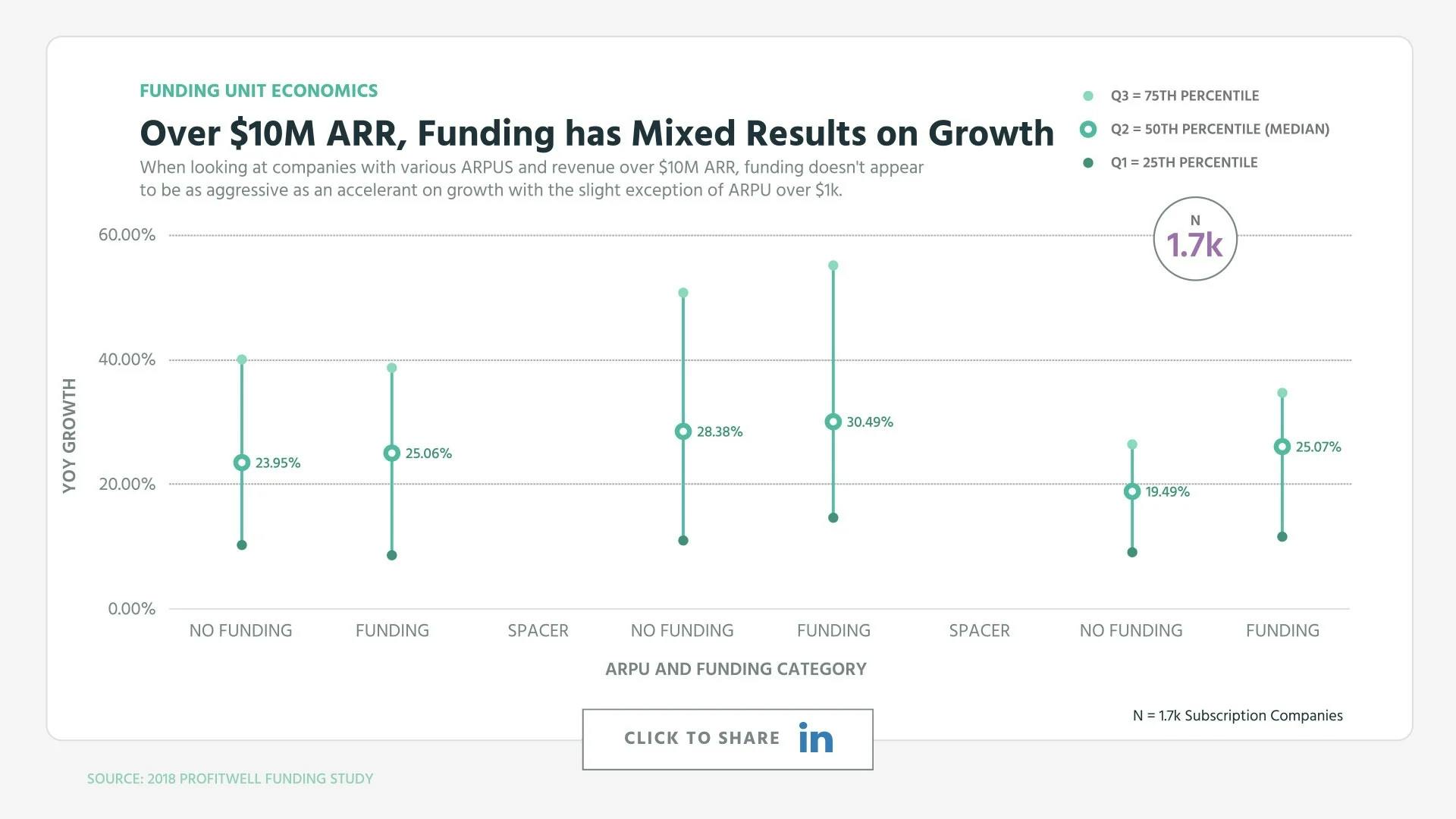
Venture Funded Companies Have Higher Churn, Less Growth
This episode might reference ProfitWell and ProfitWell Recur, which following the acquisition by Paddle is now Paddle Studios. Some information may be out of date.
Originally published: August 14, 2018
Let’s start with arguably one of the most important metrics in a subscription business - churn.

When comparing companies who took on funding to those who haven’t, you’ll note that at most stages of the growth lifecycle funded companies have higher churn with an average of 20 to 30% higher monthly gross revenue churn compared to their non-funded counterparts.
But first, if you like this kind of content and want to learn more, subscribe to get in the know when we release new episodes.

There are certainly plenty of lurking variables here, but non-funded companies likely have a bit of survivor bias baked into these numbers simply because they don’t have funding to float them through higher experimentation that is likely taking place amongst funded companies. At least that’s the most charitable interpretation of this data, as there are certainly funded companies that just use the money as a crutch instead of figuring out how to make sure they sell the right product to the right customer and keep that customer around.
When comparing customer acquisition cost data amongst these groups both interpretations are supported.

CAC is going up for everyone, but amongst funded companies we’re seeing 50 to 75% higher CAC than non-funded companies. Funded companies likely haphazardly or more targetedly use a good amount of their funding to pursue high cost channels or just more channels in general.
We’re essentially seeing different strategies along an axis of conservatism and risk. That being said, CAC and Churn obviously matter, but a common argument is that those two metrics can be optimized later - it’s all about growth. Yet, the data is mixed on whether that notion is true or not.
When we look at companies under $10M ARR it certainly is true.

Funded companies handedly are growing faster than non-funded companies. There’s no question. No matter the ARPU funded companies are growing at a rate of 40 to 100% more per year than non-funded companies with massive variance where some companies are growing at 5x that of their funded counterparts.
A counter view to this though is that there’s a massive amount of indie and lifestyle businesses that are under the $10M ARR threshold that just never want to be that large.
While not directly supporting this thesis, these gains from funding once we go over $10M in ARR seems to dissipate quite considerably.

With the slight exception of four figure or more MRR businesses, funded and non-funded companies with more than $10M ARR are essentially growing at the same rate, even when taking the entire mid-spread of the data into consideration.
So where does this put us as an industry? Well, in a sense we’re right back where we started with funding being a tool that when used properly can greatly increase your odds of reaching $10M or more.
Yet, some of the differences amongst the core unit economics, as well as how similar companies are when you reach the greater than $10M range suggest that in more cases than the industry is probably willing to admit, funding can create moral hazard and not always in the “let’s make sure we’re comfortable taking the right risk” way. Instead, funding masks core problems that simply get bigger as the company gets bigger, in essence letting you use a sledgehammer when you really should be using a scalpel.
Want to learn more? Check out our recent episode: Expansion Revenue Benchmarks and subscribe to the show to get new episodes.

1
00:00:00,320 --> 00:00:03,520
You've got the questions,
and we have the data.
2
00:00:03,520 --> 00:00:06,620
This is the ProfitWell Report.
3
00:00:08,655 --> 00:00:10,735
Hey, Patrick. It's Jeff
Wagner from Accomplice.
4
00:00:10,735 --> 00:00:11,775
Hope you're doing well.
5
00:00:11,775 --> 00:00:14,895
Big fan of your work, and
congrats on all the success.
6
00:00:14,895 --> 00:00:17,360
My question is whether you
guys have data or analysis that
7
00:00:17,360 --> 00:00:20,320
shows how venture capital
funding can impact a startup
8
00:00:20,320 --> 00:00:22,460
company's core unit economics.
9
00:00:22,560 --> 00:00:24,975
I, for one, would
love to know. Thanks.
10
00:00:25,095 --> 00:00:25,575
Okay.
11
00:00:25,575 --> 00:00:28,615
Jeff, you're asking me a question
that's absolutely going to get
12
00:00:28,615 --> 00:00:33,550
me in trouble because I'm both a VC
apologist and a bootstrap founder.
13
00:00:33,550 --> 00:00:36,270
And as we all know,
funding is a tool.
14
00:00:36,270 --> 00:00:37,870
It's not bad or good,
15
00:00:37,870 --> 00:00:40,510
but just like if you're using
a sledgehammer when you should be
16
00:00:40,510 --> 00:00:44,175
using a scalpel, you can
use the tool incorrectly.
17
00:00:44,195 --> 00:00:45,635
So to answer Jeff's question,
18
00:00:45,635 --> 00:00:48,115
we looked at the data
from three point seven thousand
19
00:00:48,115 --> 00:00:51,570
companies within the subscription
space and here's what we found.
20
00:00:51,570 --> 00:00:55,330
Let's start with arguably one
of the most important metrics
21
00:00:55,330 --> 00:00:57,985
within a subscription
business, churn.
22
00:00:57,985 --> 00:01:01,425
When comparing companies who took
on funding to those who haven't,
23
00:01:01,425 --> 00:01:04,785
you'll notice that at most
stages of the growth life cycle,
24
00:01:04,785 --> 00:01:05,301
funded companies have higher
churn with an average of twenty
25
00:01:05,301 --> 00:01:06,845
to thirty percent higher
26
00:01:12,320 --> 00:01:13,420
funded
27
00:01:14,135 --> 00:01:16,455
certainly plenty of
lurking variables here,
28
00:01:16,455 --> 00:01:19,895
but non funded companies likely
have a bit of survivor bias
29
00:01:19,895 --> 00:01:23,430
baked into these numbers simply
because they don't have funding
30
00:01:23,430 --> 00:01:26,050
to float them through
higher experimentation
31
00:01:26,150 --> 00:01:29,165
that is likely taking place
amongst funded companies.
32
00:01:29,165 --> 00:01:31,725
At least that's the most
charitable interpretation of
33
00:01:31,725 --> 00:01:34,685
this data as there are
certainly funded companies that
34
00:01:34,685 --> 00:01:38,040
just use the money as a
crutch instead of figuring out how to
35
00:01:38,040 --> 00:01:41,000
make sure they sell the
right product to the right customer
36
00:01:41,000 --> 00:01:43,240
and keep that customer around.
37
00:01:43,240 --> 00:01:46,120
When comparing customer
acquisition cost data amongst
38
00:01:46,120 --> 00:01:49,465
these groups, both
interpretations are supported.
39
00:01:49,465 --> 00:01:52,825
CAC is going up for
everyone, but amongst funded companies,
40
00:01:52,825 --> 00:01:56,390
we're seeing fifty to seventy
percent higher CAC than non
41
00:01:56,390 --> 00:01:57,590
funded companies.
42
00:01:57,590 --> 00:02:00,950
Funded companies likely
haphazardly or more targetedly
43
00:02:00,950 --> 00:02:04,070
use a good amount of their
funding to pursue higher cost
44
00:02:04,070 --> 00:02:06,995
channels or just more
channels in general.
45
00:02:06,995 --> 00:02:10,355
We're essentially seeing
different strategies along an
46
00:02:10,355 --> 00:02:13,360
axis of conservatism and risk.
47
00:02:13,360 --> 00:02:17,360
That being said, CAC and
churn obviously matter, but a common
48
00:02:17,360 --> 00:02:20,975
argument is that these two
metrics can be optimized later.
49
00:02:20,975 --> 00:02:23,215
It's all about growth now.
50
00:02:23,215 --> 00:02:27,775
Yet the data is mixed on whether
that notion is true or not.
51
00:02:27,775 --> 00:02:30,810
When we look at companies
under ten million ARR,
52
00:02:30,810 --> 00:02:32,730
it certainly is true.
53
00:02:32,730 --> 00:02:36,785
Funded companies handedly are growing
faster than non funded companies.
54
00:02:36,785 --> 00:02:38,705
There's just no question.
55
00:02:38,705 --> 00:02:40,065
No matter the ARPU,
56
00:02:40,065 --> 00:02:42,945
funded companies are growing
at a rate of forty to a hundred
57
00:02:42,945 --> 00:02:46,710
percent more per year than non
funded companies with massive
58
00:02:46,710 --> 00:02:50,150
variance where some companies are
growing at five x that of
59
00:02:50,150 --> 00:02:52,290
their non funded counterparts.
60
00:02:52,295 --> 00:02:55,495
A counter view to this though
is that there's a massive
61
00:02:55,495 --> 00:02:58,935
amount of indie and lifestyle
businesses that are under the
62
00:02:58,935 --> 00:03:02,770
ten million dollar ARR
threshold that just never want
63
00:03:02,770 --> 00:03:04,450
to be that large.
64
00:03:04,450 --> 00:03:08,450
Well, not directly supporting
this thesis, these gains from
65
00:03:08,450 --> 00:03:12,755
funding once we go over ten
million dollars in ARR seem to
66
00:03:12,755 --> 00:03:14,895
dissipate quite considerably.
67
00:03:14,915 --> 00:03:19,060
With the slight exception of four
figure or more MRR businesses,
68
00:03:19,060 --> 00:03:23,220
funded and nonfunded companies with
more than ten million ARR
69
00:03:23,220 --> 00:03:27,035
are essentially growing at the
same rate even when taking the
70
00:03:27,035 --> 00:03:30,155
entire mid spread of the
data into consideration.
71
00:03:30,155 --> 00:03:32,475
So where does this
put us as an industry?
72
00:03:32,475 --> 00:03:33,355
Well, in a sense,
73
00:03:33,355 --> 00:03:36,310
we're right back where we
started with funding being a
74
00:03:36,310 --> 00:03:39,830
tool that when used properly
can greatly increase your odds
75
00:03:39,830 --> 00:03:42,230
of reaching ten million
dollars or more.
76
00:03:42,230 --> 00:03:45,035
It's some of the differences
amongst the core unit economics
77
00:03:45,035 --> 00:03:48,235
as well as how similar
companies are when you reach
78
00:03:48,235 --> 00:03:51,860
greater than ten million
dollars suggests that in more
79
00:03:51,860 --> 00:03:55,460
cases than the industry
is probably willing to admit,
80
00:03:55,460 --> 00:03:59,380
funding can create moral hazard
and not always in the quote,
81
00:03:59,380 --> 00:04:02,085
let's make sure we're
comfortable taking the right
82
00:04:02,085 --> 00:04:04,085
risk unquote way.
83
00:04:04,085 --> 00:04:08,165
Instead, funding masks core problems
that simply get bigger as the
84
00:04:08,165 --> 00:04:09,660
company gets bigger.
85
00:04:09,660 --> 00:04:15,180
In essence, letting you use a sledgehammer
when you really should be using a scalpel.
86
00:04:15,180 --> 00:04:16,300
Well, that's all for now.
87
00:04:16,300 --> 00:04:17,485
If you have a question,
88
00:04:17,485 --> 00:04:20,525
ship me an email or video to
p c at profit well dot com.
89
00:04:20,525 --> 00:04:22,925
And let's also thank Jeff
for sparking this research by
90
00:04:22,925 --> 00:04:25,085
clicking the link below to
share and give him a nice
91
00:04:25,085 --> 00:04:26,150
little shout out.
92
00:04:26,150 --> 00:04:28,050
We'll see you next week.
93
00:04:29,910 --> 00:04:32,958
This week's episode is brought
to you by Protect the Hustle,
94
00:04:32,958 --> 00:04:37,738
a podcast about those who are in the
trenches actually doing the work.






